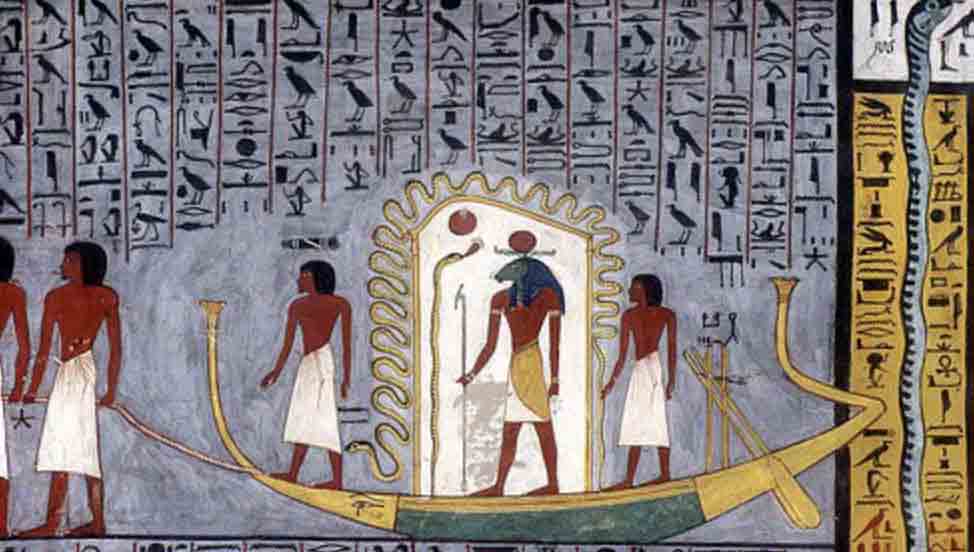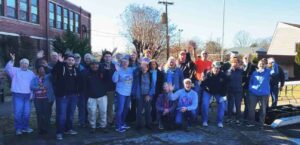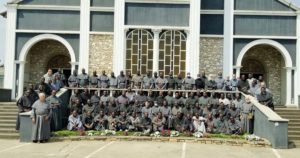Scientist-Professor-Friar Leopold Keffler continues his story. (Click here for Part 1 & for Part 2)
An extremely abbreviated and quite unfairly limited approach (how much can you cover in only forty-five class hours in a semester), the class went something like this…
Day one: A model of the universe from three civilizations about three thousand years ago. Egyptian. Earth is like a shoebox. A flat floor to the box. A sacred river running down the middle of that land. The sacred river surrounding that land. (After all, the sun god Ra had to get his canoe around from the west to the east again over night in order to ferry it across the sky again from East to West.) And mountains at the corners of the box held up that sky. (A flat earth, of limited extent, which had always been that way, and WE are in the middle, it is all for us; we are the apple of God’s eye.) Now, with that physical model, how do you theologize. Where is God? What does God’s place look like? What does God look like?
Similarly for a Hindu model, more elaborate, the flat earth held on the backs of four elephants each standing on one of the corners of the shell of a great turtle which floated in a sea of milk, and with the same ultimate descriptors, flat earth, etc. and the same theological questions asked.
The Semitic model. Essentially the same descriptors. Flat earth, three tiers, earth on which we live, above that big blue firm dome a heaven where God and his Court live, and a shadowy gray region down below where the dead go. (As St. Paul says, every knee should bend, above the earth, on the earth, and under the earth.)

Day two: By about two thousand years ago, the ancient Greeks had figured that the earth was not flat but a sphere. Ah! Now, where is up and where is down? So, the same theological questions need to be asked conforming to this new understanding. (Has anyone actually ever done that thinking? If it is true that all good theology and all good philosophy must begin from where you are instead of where people were at some different time, or where you wish you were, then that thinking must be done.)
Day three: By about five hundred years ago, and with the advent of the telescopes, it was realized that the earth was not the center of the universe but at least briefly thought the sun was. Oh! What does that do to our theological models with that transformation? Scared the bejesus out of some people just to hear that question asked, much less to think about it.
Day four: With the development of telescopes in so many ranges of the electromagnetic spectrum for analyzing many energy forms, we now know the universe is far more huge than anticipated in the past, that the sun is just one start in a galaxy of billions of stars (we call it the Milky Way, but since that is just an English translation of the word in Greek for galaxy, we are really calling it the galaxy galaxy or the Milky Way Milky Way), and that many of those spots of light we used to call stars are really galaxies so far distant that they simply appear as points of light to us. And now how do we theologize? What kinds of models can we propose about God? Heaven? Etc…

Thank God, I say, for St. Anselm and his statement, “God is that, than which, nothing greater can be thought.” That allows our sense of God to expand right along with each expansion of the universe. Also, so to speak, thank God for Jesus’ conversation with that woman at the well in the Samaritan town. She asked Jesus, where is it proper to worship? You Jews say at the temple in Jerusalem. We Samaritans say on Mount Garizim. And Jesus says, ‘There is a day when God will be worshiped in neither of those places but must be worshiped in “spirit and Truth because God is a Spirit.”’ What wonderful foresight!
And with our present state of knowledge we understand the universe began with some infusion of energy (so to study it we must know something about physics and motion and thermodynamics and laws of motion and of planetary motion) and has been in a constant state of evolution from that initial unimaginably intense infusion (Creation) of energy which eventually cooled enough that charged bits of energy could associate with one another and form atoms, and later molecules, and much later eventually begin to self-replicate (is that a redundancy?) and life began and has also been evolving from that point.
– friar Leopold Keffler OFM Conv.
Tomorrow, October 4, we celebrate the Feast of St. Francis and the ‘end’ of the Season of Creation. In the final part of friar Leopold’s reflection, he reminds us that the Season of Creation is really forever!



